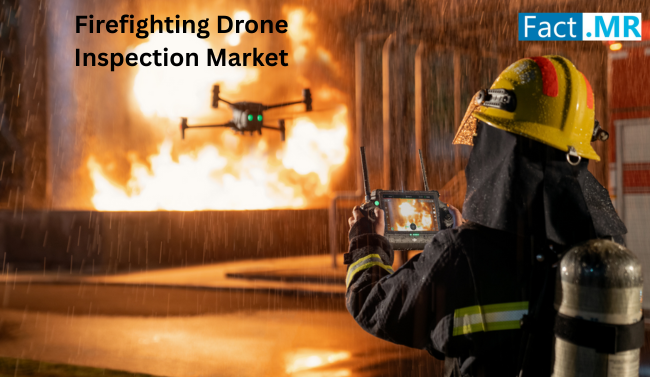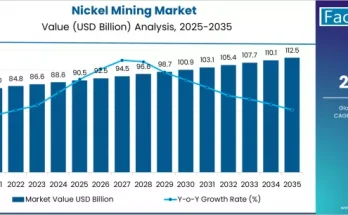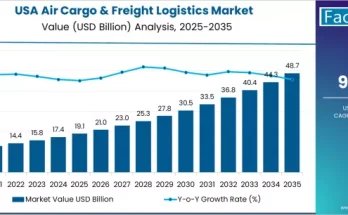The Firefighting Drone Inspection Market is rapidly gaining momentum as advanced technologies redefine how aerial systems support emergency response, surveillance, and prevention. With global demand accelerating, the market is expected to surge from a valuation of approximately US$596.6 million in 2023 to US$2.89 billion by 2033, growing at a robust CAGR of 17.1%. This expansion is being driven by increasing climate-related fire incidents, rising urban density, and the growing demand for safer, faster, and smarter firefighting tools.
Market Drivers & Growth Opportunities
Escalating Fire Risk Across the Globe
Increasing wildfires, industrial incidents, and urban fire outbreaks are placing enormous pressure on firefighting agencies worldwide. Drones are emerging as a frontline solution, offering thermal imaging, gas sensing, and real-time mapping. These capabilities empower firefighters with the visibility needed to make faster, life-saving decisions while minimizing exposure to dangerous environments.
Technological Advancements in UAV Systems
Dramatic improvements in drone technology—ranging from battery longevity and payload capacity to AI-driven navigation—are enabling longer flight times and more accurate inspections. Drones are now capable of operating autonomously, carrying fire retardants, capturing live thermal footage, and even conducting inspections over rugged terrain or inside burning structures.
Expanding Use Cases Beyond Emergencies
The utility of firefighting drones extends far beyond emergency scenarios. They are increasingly deployed for preventive inspection of infrastructure, forests, and industrial zones, identifying risks like electrical faults, gas leaks, or overgrown vegetation before they ignite into disasters. This shift toward pre-emptive safety planning is unlocking new commercial and government demand.
Strategic Collaboration on the Rise
Public-private partnerships and technology integrations between fire departments, drone manufacturers, and software providers are streamlining deployment and creating more adaptable, mission-specific UAV systems. These collaborations are essential in customizing solutions to local fire risks, terrain, and operational protocols.
Market Challenges
Airspace Regulations & Policy Gaps
Despite their benefits, drones face complex regulatory environments. Limitations such as restricted airspace, flight approval times, and restrictions on beyond visual line of sight (BVLOS) operations can hinder rapid deployment during emergencies. Policymakers are working to revise frameworks, but progress remains uneven across regions.
High Initial Investment & Training Requirements
Advanced firefighting drones equipped with thermal cameras, LiDAR, or large payload capacities can be expensive. Smaller municipalities or volunteer-based departments may struggle with affordability. Additionally, teams require specialized training for drone operation, data interpretation, and flight planning—further adding to the cost and complexity.
Technical Constraints
Battery limitations continue to restrict mission duration, particularly in high-intensity fires where persistent aerial surveillance is needed. Environmental challenges such as smoke, rain, wind, and high temperatures can also interfere with drone flight stability and data accuracy.
Key Market Insights
- Market size is projected to grow from US$596.6 million (2023) to US$2.89 billion by 2033.
- Multi-rotor drones are the preferred platform type due to their maneuverability and ease of vertical take-off and landing.
- Fixed-wing and hybrid drones are gaining traction for long-distance monitoring and large-scale wildfire coverage.
- North America currently leads in market share, while Asia-Pacific is expected to exhibit the fastest growth due to increasing industrial development, urban expansion, and fire-related threats.
Real-World Use Cases
- Wildfire Detection & Monitoring
Drones equipped with thermal cameras fly over active fires, mapping their progress, identifying hotspots, and enabling resource teams to plan suppression strategies more effectively. - Urban Firefighting Support
In dense urban environments, drones provide top-down perspectives that reveal roof collapses, trapped occupants, or secondary hazards. These insights speed up rescue operations and improve crew safety. - Post-Fire Damage Assessment
After the fire is extinguished, drones help assess property damage, infrastructure risks, and structural integrity without sending personnel into dangerous environments. - Industrial & Infrastructure Inspections
Drones perform routine surveillance of chemical plants, oil rigs, transmission lines, and other fire-prone assets. By identifying heat build-up or hazardous leaks early, fire risks can be mitigated before they become critical.
Innovation & Emerging Trends
- AI-Driven Drones: Artificial intelligence is being embedded into UAV systems to analyze visual and thermal data, track fire movement, and predict spread patterns in real time.
- Swarm Coordination: Multiple drones can now work collaboratively, each covering a segment of the affected zone. This swarm technology allows for broader coverage with minimal human oversight.
- Tethered Drones: Drones connected via cables to power sources on the ground are gaining attention for continuous monitoring in stationary zones, such as during night operations or command center surveillance.
- Smart Interfaces & Control Systems: New user-friendly platforms make it easier for non-specialists to control drones during emergency situations, accelerating adoption even in resource-constrained departments.
Strategic Recommendations
For Fire Departments & Emergency Agencies:
- Start small by integrating drones into training simulations and low-risk fire scenarios.
- Invest in multi-use drones with modular payloads for both emergency and inspection purposes.
- Partner with drone-as-a-service (DaaS) providers to avoid high upfront costs.
For Technology Providers:
- Focus on developing drones with longer battery life, ruggedized construction, and user-friendly control interfaces.
- Enable software integrations with real-time GIS mapping and emergency response systems.
- Offer scalable solutions tailored to the needs of rural, urban, and industrial clients.
For Policymakers & Regulatory Bodies:
- Accelerate the development of emergency-use exemptions and streamlined airspace access for firefighting drones.
- Standardize training and certification frameworks across regions to support cross-border mutual aid.
Final Thoughts
The Firefighting Drone Inspection Market is no longer a future prospect—it’s a fast-moving reality that is transforming how fires are detected, assessed, and contained. As climate change and urban expansion increase fire risks, drone-enabled solutions offer unmatched speed, data clarity, and operational safety.
For stakeholders in emergency response, public safety, tech innovation, or drone manufacturing, the opportunity is massive. By embracing aerial intelligence today, we’re not just improving firefighting—we’re saving lives, reducing loss, and building resilience into the future of safety.



